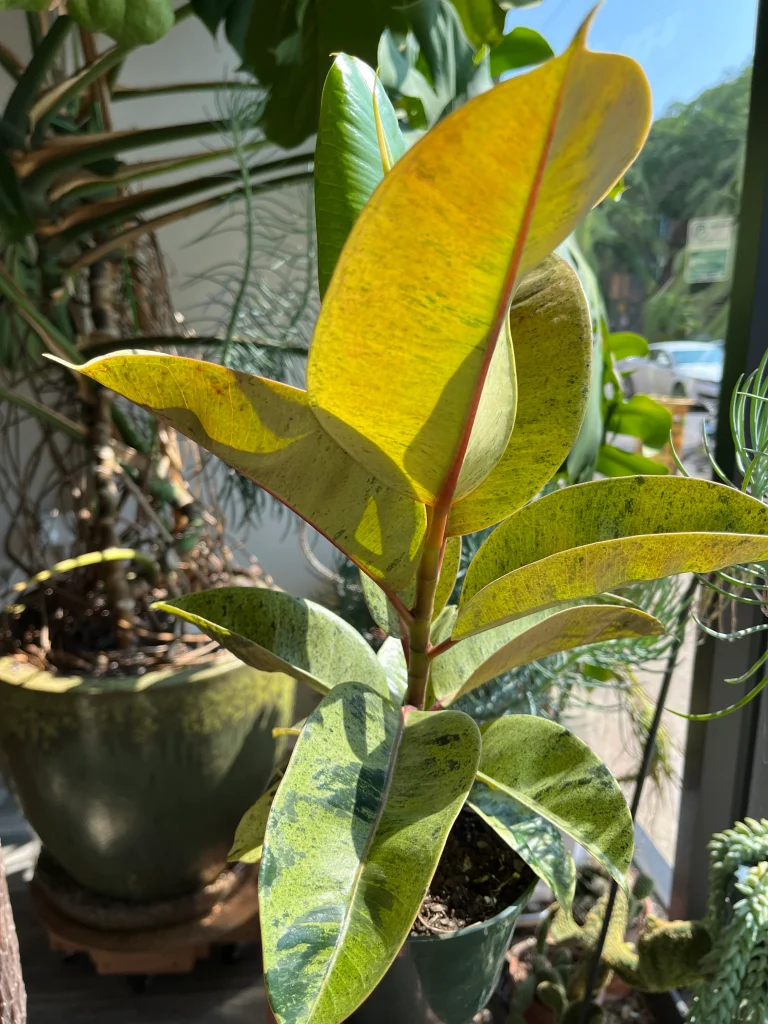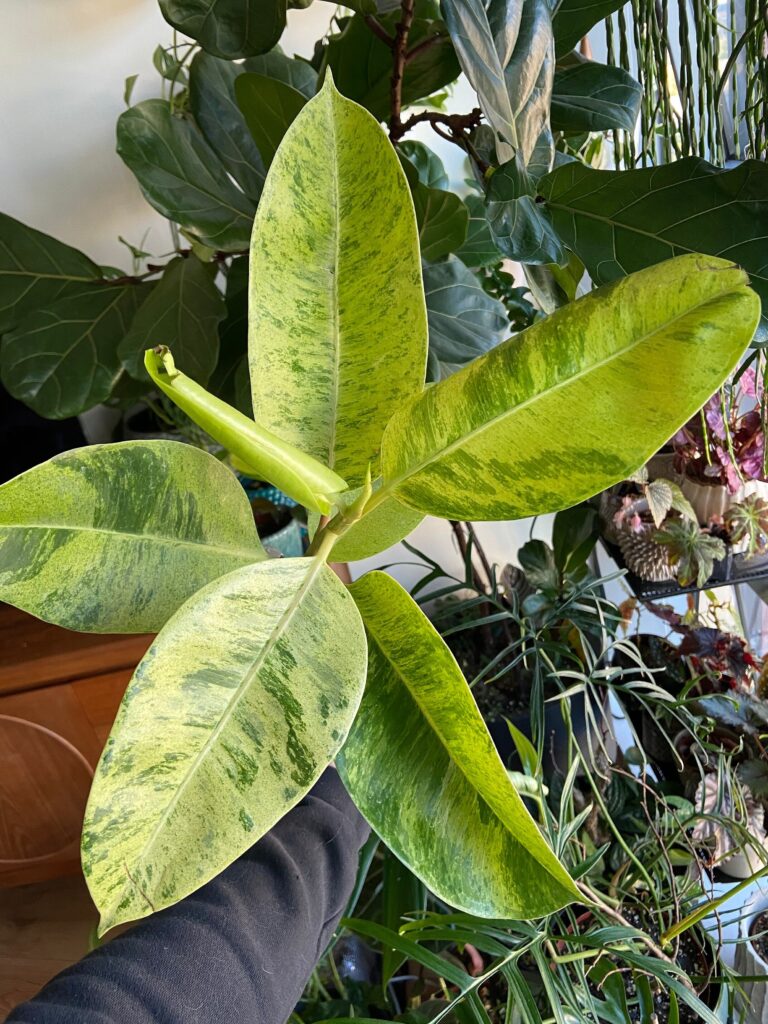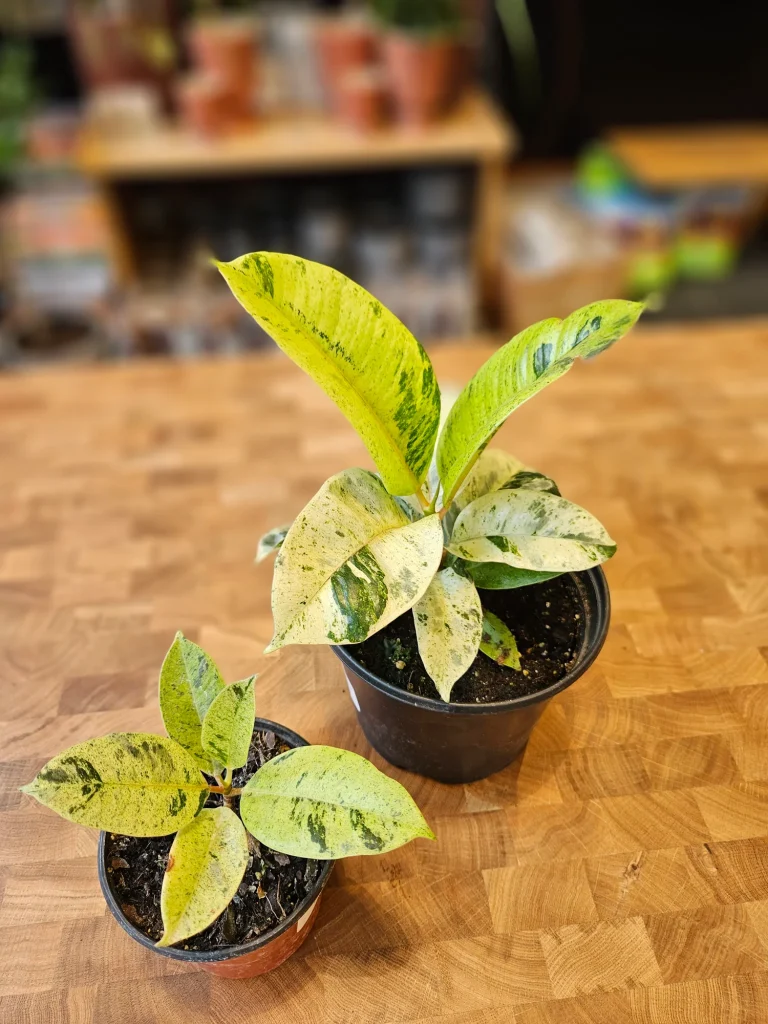Ficus shivereana is a remarkable addition to the vast world of indoor plants, captivating enthusiasts with its unique foliage and numerous benefits. Belonging to the Ficus genus ficus shivereana is a plant that catches attention with its beauty and offers benefits, to both homes and offices. This article takes a look, into the origins of ficus shivereana its care needs and other interesting aspects worth exploring.
What Is Ficus Shivereana?
Ficus shivereana is a species, among the extensive Ficus genus. It naturally thrives in regions showcasing its distinctive foliage patterns and textures. Being part of the Moraceae family it has gained popularity among plant enthusiasts and collectors globally. Its presence in homes and offices brings a touch of natures beauty infusing spaces, with vibrancy and liveliness.
Ficus Shivereana Benefits
- Ficus shivereana offers advantages when it comes to air purification. Its leaves have the ability to absorb pollutants ensuring that indoor spaces remain fresh and clean.
- Additionally this plant acts as a humidifier by releasing water vapor. This helps to maintain and increase moisture levels in environments.
- Beyond its benefits ficus shivereana also adds a touch of appeal. With its appearance it can enhance the look of any room.
- Moreover studies have shown that having plants, like ficus shivereana around can contribute to reduced stress levels improved focus and an overall sense of well being.
Are Ficus Trees Evergreen?
Yes most ficus trees, including the ficus shivereana keep their leaves all year round. This feature makes them a great choice, for adding greenery to both spaces. The fact that they stay green throughout the year is one of the reasons why they’re plants as they bring vibrancy even during colder months.
Are Ficus Berries Edible?
Ficus trees produce fruits that are often called figs or berries. Some species of these fruits are enjoyed by both humans and wildlife while others can be harmful if consumed. It’s crucial to identify the type of ficus tree before considering eating its fruits. It’s always advisable to consult with experts or trusted sources, for guidance before consuming any plant or fruit.
Are Ficus Trees Invasive?
Some types of ficus plants can become invasive especially when they are brought to areas where they are not naturally found. Their rapid growth and extensive root systems can outcompete plants, leading to disruptions, in ecosystems. However when grown in controlled environments or, in their habitats they tend to coexist with other plants.
Are Ficus Tree Berries Edible?
As I mentioned before the edibility of ficus berries varies depending on the species. Some types are both delicious and nutritious while others can actually be harmful if eaten. It’s always important to make sure you correctly identify the berries and seek advice, from experts before consuming them.
Can Ficus Trees Survive Winter?
Ficus trees, such, as ficus shivereana are commonly found in regions where they thrive in climates. However if you decide to keep them indoors during the winter months they can still survive. It’s important to be mindful of temperatures as they can cause the leaves to fall off or even lead to the trees demise. To ensure their health and happiness it is crucial to create an environment that minimizes temperature fluctuations.

Can Ficus Survive Outdoors?
Ficus shivereana is primarily suitable, for cultivation. It can also be grown outdoors in regions with a climate. When selecting a spot, for it ensure that it receives filtered sunlight and is protected from weather conditions.
Can Ficus Benjamina Live Outside?
The Ficus benjamina, commonly referred to as the weeping fig is a plant that flourishes in climates and can be cultivated outdoors. However it’s crucial to keep in mind that this particular plant is quite sensitive, to temperature fluctuations. In regions, with winters it is advisable either to bring the plant indoors or take precautions to ensure its adequate protection.
Ficus Shivereana Origin
The Ficus shivereana plant originates, from areas. It stands out with its leaf designs and textures making it highly desirable for plant collectors and gardening enthusiasts alike. As time has passed its appeal has grown, leading to its inclusion in plant collections, around the globe.
Ficus Shivereana Propagation
Plant propagation is a part of plant care as it allows plant enthusiasts to expand their collections. Here’s a step, by step guide on how to propagate ficus shivereana;
- Choose a stem; Select a stem from the parent shivereana plant that’s in good health and has 2 3 leaves.
- Make the cut; Carefully cut the chosen stem below a node using sterilized scissors or pruning shears.
- Prepare the rooting medium; You have two options for the rooting medium. Either place the cutting in water or directly into draining soil. If you choose water remember to change it every days to keep it fresh. If you opt for soil ensure that it has drainage.
- Create warmth and humidity; Find a spot, with humidity to place the cutting. You can maintain humidity levels by using a bag or a propagation box.
- Be patient and observant; After a week you should start seeing roots developing from the cutting. Once these roots are well established you can transfer the cutting into a pot.
Do Ficus Trees Shed Leaves?
Yes, ficus trees, including ficus shivereana, can shed leaves, especially when exposed to stress. There are factors that can cause this response, such, as alterations in water levels lighting conditions, temperature fluctuations or when the plant is moved to a different location. It’s crucial to keep an eye on the plant and make adjustments, to its care routine in order to stabilize it and prevent excessive leaf shedding.
Do Ficus Trees Have Seeds?
Ficus trees bear fruits called figs and these figs often contain seeds. However it’s important to note that not all ficus species have seeds, for reproduction. In instances the involvement of wasp species is necessary, for pollination, which adds complexity to the natural seed production process.

Do Ficus Trees Go Dormant?
Unlike trees that drop their leaves and become inactive in months ficus trees don’t actually go into a state of dormancy. However they may experience growth when there is light or colder temperatures. It’s important to modify the care routine during these periods by reducing watering and making sure the plant gets light.
Do Ficus Go Dormant?
To emphasize what was mentioned earlier ficus trees typically do not go into a state. While they may decrease their growth rate in conditions they stay active all year round.
Do Ficus Trees Have Berries?
Yes, Ficus trees bear fruit that is commonly called berries or figs. The size, color and edibility of these fruits may differ depending on the species. Some are enjoyed by humans while others provide food for wildlife.
Does Ficus Tree Need Sun?
Ficus trees rely on sunlight, for their growth and overall health. Similar to ficus varieties Ficus shivereana thrives in indirect sunlight. It requires an amount of light to flourish. Excessive exposure to direct sunlight especially, during peak hours can cause the leaves to become scorched and turn brown or yellow. Striking the balance is crucial allowing the plant to receive light while avoiding harsh sun rays.
Ficus Shivereana For Sale
Because shivereana is becoming increasingly popular you can find it for sale, in nurseries and online plant stores. It’s crucial to select a seller when purchasing this plant to guarantee that you receive a specimen. The price may differ depending on the size, health and rarity of the plant.
How To Care For Ficus Shivereana
Caring for ficus shivereana requires attention to detail and a good understanding of its needs. Here’s a comprehensive guide, on how to care for this plant;
- Lighting; Ensure that the plant receives indirect sunlight and avoid direct exposure to the sun.
- Watering; It’s important to water the plant when the top inch of soil feels dry. However be mindful of reducing watering during months.
- Soil; Choose a draining potting mix that combines potting soil with perlite or sand.
- Temperature; Maintain a temperature range of 65 75°F (18 24°C) for your ficus shivereana and try to avoid temperature fluctuations.
- Humidity; This type of plant prefers moderate humidity levels. You can consider using a humidifier or placing the plant on a tray with pebbles and water to increase humidity levels.
- Fertilization; During the growing season feed your shivereana with fertilizer once a month. Reduce fertilization frequency during winter months.
- Pruning; Regularly trim your plant to maintain its shape and remove any yellowing leaves.
- Pest Control; Keep an eye out for pests such, as spider mites, aphids and mealybugs. If you notice any infestation treat it with soap or neem oil as needed.
This guide will help you provide care for your ficus shivereana ensuring its health and vitality.

How To Propagate Ficus Shivereana
Here’s a useful guide, for plant lovers who want to propagate their shivereana plants and share them with loved ones. The recommended method for propagation involves using stem cuttings. Follow these steps;
- Choose a stem; Select a stem from the parent plant that has 2 3 leaves and is in condition.
- Making the cutting; Use sterilized scissors to make a cut below a node on the chosen stem.
- Rooting; Place the cutting either in water or a rooting medium ensuring that you change the water regularly to keep it fresh.
- Creating conditions; Create an environment, for the cutting by using either a plastic bag or a propagation chamber.
- Transplantation; Once roots have developed carefully transplant the cutting into a pot filled with well draining soil.
By following these steps you’ll be able to propagate your ficus shivereana plant and expand your collection!
How To Grow Ficus
Growing ficus plants, including ficus shivereana requires understanding their requirements and creating an environment for them. Below is a step, by step guide to successfully cultivate ficus plants;
- Choose the Perfect Spot; Ficus plants thrive in indirect sunlight. Look for a location in your home that receives natural light while being protected from direct sun exposure.
- Watering; It’s important to water the plant when the top layer of soil feels dry. Avoid overwatering as it can lead to root rot, which’s detrimental to the plants health.
- Soil Selection; Opt for a draining potting mix when planting your ficus. You can enhance soil by incorporating perlite or sand to ensure proper drainage.
- Temperature and Humidity; Ficus plants prefer temperatures ranging from 65-75°F (18-24°C). Thrive in humidity levels. If you reside in a region consider using a humidifier to maintain conditions.
- Fertilization; During the growing season provide your ficus plant with fertilizer once every month. However reduce fertilization during winter months when growth slows down.
- Pruning Maintenance; Regularly trim your ficus plant to maintain its desired shape and encourage growth patterns. Remove any dead or yellowing leaves promptly as they can affect plant health.
- Pest Management; Stay vigilant for pests such, as spider mites, aphids and mealybugs that may infest your ficus plant. Treat any infestations promptly using soap or oil based solutions.
Is Ficus Elastica Shivereana Rare?
The Ficus elastica shivereana is a variation found in the Ficus family. Its unique look, marked by its leaf designs and textures makes it highly desired among plant lovers. Depending on the location and supply it can be considered uncommon. However its popularity has resulted in more people growing it making it easier to find in times.
Is Ficus Hard To Grow?
Ficus plants are typically quite versatile. Can thrive in a range of environments. However some species can be a bit temperamental. Have care requirements. Elements such, as sunlight, watering, temperature and humidity all play roles in their health. By providing the care and attention ficus plants, including ficus shivereana have the potential to grow beautifully and become standout features, in both spaces and outdoor gardens.

Ficus Shivereana Vs. Moonshine
Ficus shivereana and ‘Moonshine’ are two plants, in the world of flora. Although they both fall under the Ficus genus ‘Moonshine’ is a variety that stands out due to its looks. Each plant possesses its features care demands and visual charm. When deciding between the two it’s important to take into account aspects such, as availability, care requirements and personal preferences.
Why Ficus Leaves Turn Brown?
When you notice leaves on a ficus plant it’s natural to be concerned. There are factors that can contribute to this problem;
- Insufficient watering; If the plant doesn’t receive water its leaves may turn brown and become dry and brittle.
- Excessive watering; Giving the plant water can lead to root rot, which causes the leaves, to brown and droop.
- Direct sunlight exposure; When the ficus plant is exposed to sunlight the leaves can get scorched and turn brown.
- Infestation; The presence of pests, like spider mites can also cause the leaves to turn brown.
- Fungal infections; Certain types of diseases can result in spots appearing on the leaves.
It’s crucial to identify the underlying issue and take action to address it.
Why Ficus Leaves Turn Yellow?
When the leaves of a ficus plant start turning yellow it can indicate issues;
- Overwatering; Giving water to the plant can cause root rot, which in turn leads to yellowing and dropping of leaves.
- Poor Drainage; If the soil doesn’t drain properly it can result in waterlogged conditions causing the leaves to turn yellow.
- Insufficient Light; Ficus plants need indirect light. If they don’t receive light their leaves may turn yellow.
- Nutrient Deficiency; When essential nutrients are lacking in the soil it can cause the leaves to become yellow.
It’s important to identify the underlying problem and adjust your care routine accordingly.
Will Ficus Leaves Grow Back?
Yes, with the right care and conditions, ficus plants can regrow lost leaves. If a ficus plant has lost its leaves because of stress or unfavorable conditions it is important to stabilize the plant and give it the care. With patience and time the plant has the potential to bounce back and grow leaves.
Will A Ficus Tree Come Back To Life?
If you notice a ficus tree that seems lifeless or, under stress don’t lose hope. By giving it the care and attention there’s a chance to revive a ficus tree. Before giving up on the plant look for signs of life, like stems or new growth. Adjust your care routine. Provide the plant with conditions and over time it may regain its vitality.
Large Ficus Shivereana
When you witness a grown ficus shivereana it is truly a sight. Its tall and striking appearance along, with its leaves make it a standout choice, among plants. A mature ficus shivereana not reflects the plants well being. Also speaks volumes about the nurturing and devotion it has received throughout its lifespan.

Ficus Shivereana For Sale
Ficus shivereana has become incredibly popular, among plant lovers resulting in a demand for it. You can find it for sale in sizes ranging from starter plants to big fully grown ones. The prices may differ depending on factors such, as size, health, rarity and where the seller is located. When purchasing a ficus shivereana it’s important to select a seller to guarantee that you receive an authentic plant.
Ficus Shivereana Variegated
The captivating version of ficus shivereana is truly a sight to behold. With its leaves displaying an array of colors this variant brings a burst of vibrancy and contrast, to any collection of plants. The mix of white and occasionally pink tones on the leaves makes it highly coveted, among plant enthusiasts.
Ficus Shivereana Australia
Ficus shivereana has gained popularity, among plant enthusiasts in Australia. This plant is mainly suited for cultivation due to the climate of the country. However it can also be grown outdoors in regions with a climate. Australian gardeners and plant collectors admire its adaptability and distinctive appearance making it a favored choice, in their gardens.
Ficus Shivereana Brown Spots
Brown spots, on the leaves of ficus shivereana can be a cause for concern. There are factors that can contribute to this problem;
- Overwatering; Giving the plant water can create conditions for fungal infections, which result in brown spots on the leaves.
- Pest Infestation; Pests like spider mites can also be responsible for causing browning of the leaves.
- Direct Sunlight; Exposing the plant to sunlight can lead to leaf scorching resulting in spots.
- Fungal Diseases; Certain types of infections can also cause spots, on the leaves.
It is crucial to identify the issue and take measures promptly to address it effectively.
Buy Ficus Shivereana
If you’re interested, in adding a ficus shivereana to your plant collection there are avenues to explore. Local nurseries typically have a selection of ficus plants, including ficus shivereana. Moreover online plant stores and marketplaces provide a range of choices that cater to sizes and budgets. When purchasing online it’s essential to select a seller and review customer feedback to ensure the plant you receive is healthy.

Ficus Shivereana Canada
In Canada due, to the weather ficus shivereana is mainly cultivated as a plant. Many plant enthusiasts in Canada are drawn to its air purifying qualities and the touch of green it brings. There are nurseries and online plant shops that sell ficus shivereana meeting the increasing demand, for this plant.
Ficus Shivereana Cutting
To start propagating ficus shivereana you’ll need to take a cutting from a stem of the parent plant. Make sure the stem has 2-3 leaves and use a clean sterilized pair of scissors or pruning shears to make a precise cut just below a node. This cutting can then be used for propagation, in either water or soil.
Ficus Shivereana Cuidados
Taking care of ficus shivereana or shiver fig requires attention to factors including light, water, soil and the overall environment. Make sure the plant gets plenty of indirect sunlight. Water it when the top layer of soil feels dry and use a mix that drains well. Keep an eye out for pests and diseases. Act promptly if any problems arise.
Ficus Shivereana Full Grown
A mature ficus shivereana is truly a sight. Its abundant greenery leaf designs and commanding presence make it the focal point of any room or garden. Growing a developed plant necessitates dedication, patience and regular nurturing. By providing conditions and giving it the attention it deserves the ficus shivereana can. Reach its maximum growth potential.
Ficus Shivereana Moonshine For Sale
The ‘Moonshine’ variation of ficus shivereana is highly desired because of its look. With its leaf designs and vibrant colors it’s a favored choice, among plant enthusiasts. You can find this variant, in nurseries and online plant shops. The price may differ depending on the size, condition and how easy it is to find.
Ficus Shivereana Leaves Falling Off
When the leaves of a ficus shivereana start falling off it could indicate that the plant is experiencing stress or unfavorable conditions. This can happen due, to factors such as giving it much water not giving it enough water sudden changes in temperature or if there are pests infesting the plant. It is important to identify the cause and make adjustments, to how you take care of the plant in order to stabilize it and prevent leaves from falling off.
Ficus Shivereana Growth Rate
The rate at which ficus shivereana grows can differ depending on factors such, as light, water, soil. How well it is taken care of. When provided with conditions ficus shivereana tends to grow increasing its height by a few inches every year. Regular pruning can also impact its growth rate by encouraging growth and a compact shape.
Ficus Shivereana Moonshine Large
The impressive ‘Moonshine’ version of ficus shivereana is truly a work of art. With its foliage leaf designs and commanding presence it effortlessly becomes the center of attention in any setting. This particular variant showcases the beauty and remarkable variety that the Ficus genus offers.
Ficus Shivereana Price
The cost of ficus shivereana can differ depending on factors such, as its size, health, rarity and where the seller is located. Generally smaller plants tend to be more budget friendly while larger and grown specimens may have a price tag. Moreover unique variations like ‘Moonshine’ or those with variegated patterns might be priced higher due to their look and popularity, among buyers.
Ficus Shivereana Pink
The rare and highly coveted pink form of ficus shivereana is an addition, to any plant collection. With its shades it brings a splash of color and adds a charming contrast. Plant enthusiasts and collectors alike treasure this variant, for its hues and distinctive look.

Ficus Shivereana Pflege
Taking care of ficus shivereana also known as caring for it involves creating the environment for the plant to thrive and prosper. This includes making sure it gets sunlight, water and nutrients. It’s important to inspect for pests and diseases and take action if any problems arise. By providing care ficus shivereana can. Become a remarkable addition, to any plant collection.
Ficus Shivereana Rubber Plant
Ficus shivereana is part of the Ficus genus. Its different, from the rubber plant also known as Ficus elastica. Both plants have their features, care needs and visual charm. While they do share some similarities they are species, within the Ficus genus.
Ficus Shivereana Soil
Having the correct soil is essential, for the vitality and wellness of ficus shivereana. This particular plant thrives when planted in a mix that allows for drainage preventing any potential root rot issues. A blend of soil, perlite and sand can create an ideal environment by striking a harmonious balance, between retaining moisture and facilitating effective drainage.
Ficus Shivereana Snow Storm
The ‘Snow Storm’ version of ficus shivereana is truly captivating to the eye. With its leaves adorned in patterns it brings a delightful contrast and liveliness to any collection of plants. This particular variation serves as an example of the beauty and vast range found within the Ficus genus.
Ficus Shivereana Singapore
Ficus shivereana has gained popularity, among plant enthusiasts in Singapore. This plant is well suited for both outdoor environments due to the countrys climate. Its distinctive appearance and ability to purify the air have made it a beloved choice among plant lovers, in Singapore.
Ficus Shivereana Watering
To properly water ficus shivereana it’s important to find a balance. You want to keep the soil moist but not overly saturated. Giving water can result in root rot while not watering enough can cause the plant to dry out. Its recommended to water the plant when the top layer of soil feels dry, to the touch. This way you’ll provide moisture for the roots without drowning them.
Final Thought
The ficus shivereana is more than just a decorative plant; it’s a testament to nature’s beauty and adaptability. Whether you’re a plant lover or someone new, to adding a hint of nature to your surroundings ficus shivereana is definitely worth considering. This plant offers a look. Has the added benefit of purifying the air making it an essential addition, for any plant enthusiast. Like any plant it’s important to grasp its requirements and provide consistent care to ensure its long term growth and vitality.
 Usalia
Usalia



